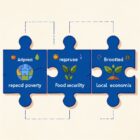6 Ways Food Stamps Bolster Local Economies

Did you know that food stamps have a significant impact on local economies? In fact, they play a crucial role in bolstering communities across the country.
With increasing consumer spending, support for local businesses, and a boost in employment opportunities, food stamps are not only alleviating poverty but also strengthening local agriculture and encouraging entrepreneurship.
In this article, we will explore six compelling ways that food stamps contribute to the growth and prosperity of our local economies.
Key Takeaways
- Food stamps generate $9 in economic activity for every $5 in new SNAP benefits.
- Increased spending from food stamp recipients supports local businesses.
- Food stamp programs foster economic growth and contribute to the overall vitality of the community.
- Food stamps increase the purchasing power of eligible households and lead to business expansion and job creation.
Increasing Consumer Spending
You can increase consumer spending by utilizing food stamps. Food stamps, also known as the Supplemental Nutrition Assistance Program (SNAP), provide low-income individuals and families with funds to purchase food. By doing so, food stamps not only alleviate hunger but also have a positive impact on local economies.
According to a report by the United States Department of Agriculture (USDA), every $5 in new SNAP benefits generates a total of $9 in economic activity. This means that for every dollar spent on food stamps, $1.80 is added to the local economy.
The reason behind this economic boost is simple: when individuals and families have access to food stamps, they’ve more money to spend on other goods and services. This increased spending creates a ripple effect, benefiting businesses and stimulating economic growth. In fact, a study conducted by the National Bureau of Economic Research found that during times of economic downturn, every dollar increase in SNAP benefits leads to a significant increase in household spending. This not only supports local businesses but also contributes to job creation and income growth.
In addition to increasing consumer spending, food stamps also have a multiplier effect on the economy. The USDA estimates that for every $1 billion invested in SNAP, it generates an additional $1.54 billion in economic activity. This demonstrates the significant impact that food stamps have in stimulating economic growth at both the local and national levels.
Supporting Local Businesses
Food stamps not only provide crucial nutrition support to families in need, but they also play a significant role in supporting local businesses and fostering economic growth.
When recipients use their food stamps to purchase groceries from local stores and farmers markets, it directly boosts sales for these businesses. This increased demand allows local businesses to expand their operations, hire more employees, and contribute to the overall economic vitality of the community.
Encouraging Economic Growth
Supporting local businesses through food stamp programs can have a positive impact on economic growth in communities. By enabling low-income individuals to purchase goods and services from local retailers, these programs create a ripple effect that stimulates the local economy. According to a study conducted by the United States Department of Agriculture (USDA), every $5 in new SNAP benefits generates $9.20 in total community spending. This increased spending not only supports local businesses but also generates job opportunities within the community. Moreover, the USDA study found that for every additional $1 billion in SNAP benefits, approximately 8,900 full-time equivalent jobs are created. By encouraging economic growth through food stamp programs, communities can experience increased economic activity and improved overall well-being.
| Food Stamp Programs Support Local Businesses |
|---|
| Stimulate local economy |
| Generate job opportunities |
| Improve overall well-being |
Boosting Small Businesses
Boosting small businesses through food stamp programs can have a significant impact on local economies. By supporting local businesses, food stamp programs help stimulate economic growth and create job opportunities within the community.
According to a study conducted by the USDA, every $1 in food stamp benefits generates $1.79 in economic activity. This multiplier effect occurs as food stamp recipients spend their benefits at local grocery stores, farmers markets, and small businesses, which in turn stimulates the local economy.
Additionally, small businesses that accept food stamps often experience an increase in customer traffic, leading to higher sales and revenue. This not only benefits the business owners but also allows them to hire more employees, contributing to the overall growth and prosperity of the local economy.
Boosting Employment Opportunities
Are you aware of how food stamps can contribute to increasing job opportunities in your community?
Food stamps, also known as the Supplemental Nutrition Assistance Program (SNAP), not only provide assistance to low-income individuals and families, but they also play a vital role in boosting employment opportunities. By increasing the purchasing power of eligible households, food stamps stimulate local economies and generate job growth.
When individuals and families receive food stamps, they’re able to spend more on groceries and other essential items. This increased demand for goods and services leads to an expansion of businesses, which in turn creates more job opportunities. According to a study conducted by the U.S. Department of Agriculture, every $1 billion in SNAP benefits generates an estimated 8,900 to 17,900 full-time equivalent jobs.
Furthermore, food stamps have a multiplier effect on employment. As households spend their benefits, businesses experience increased sales, allowing them to hire additional staff to meet the growing demand. This creates a positive cycle of job creation and economic growth in local communities.
In addition to boosting employment in the retail sector, food stamps also support jobs in the agricultural industry. SNAP benefits enable low-income households to purchase more food, thereby increasing demand for farm products. This increased demand leads to higher production levels, which necessitates more labor on farms.
Strengthening Local Agriculture
By promoting sustainable farming practices, food stamps can play a significant role in strengthening local agriculture. This not only benefits the environment but also supports local farmers and boosts rural economies.
With increased access to fresh, locally grown produce, food stamp recipients can contribute to the growth and sustainability of their communities while enjoying nutritious meals.
Promoting Sustainable Farming
Supporting local agriculture is essential for strengthening the sustainability and resilience of our community’s food system. By promoting sustainable farming practices, we can ensure the long-term viability of our local farms while also protecting our environment.
Here are three ways in which sustainable farming can be achieved:
- Implementing organic farming techniques: By avoiding the use of synthetic pesticides and fertilizers, organic farmers prioritize the health of the soil, water, and surrounding ecosystem. This not only produces healthier, more nutritious food but also reduces the negative impact on the environment.
- Encouraging crop rotation and diversification: Farmers who rotate crops and vary their plantings help prevent soil erosion, maintain soil fertility, and minimize the risk of pests and diseases. This practice also promotes biodiversity and supports the overall health of the ecosystem.
- Supporting regenerative agriculture: By focusing on regenerative practices such as cover cropping, conservation tillage, and composting, farmers can improve soil health, increase carbon sequestration, and enhance water retention. These practices not only benefit the environment but also contribute to the long-term sustainability of our local food system.
Boosting Rural Economies
To strengthen local agriculture and boost rural economies, you can actively contribute by investing in local food producers and supporting their businesses. This not only helps farmers and food producers thrive but also has positive economic impacts on local communities.
When you buy locally grown and produced food, you’re directly supporting the local agricultural industry. According to a study conducted by the United States Department of Agriculture, every dollar spent on local food generates an additional $1.80 in economic activity. This multiplier effect occurs because local food purchases create jobs, increase demand for local products, and stimulate the local economy.
Additionally, investing in local food producers helps to preserve farmland and sustains rural communities, ensuring their continued economic viability. By choosing to support local agriculture, you’re making a significant contribution to the overall strength of rural economies.
Encouraging Entrepreneurship
Entrepreneurship thrives when individuals on food stamps are empowered to utilize their skills and resources. By providing support and opportunities, food stamps can encourage entrepreneurship and drive local economic growth. Here are three ways in which food stamps can empower individuals to become successful entrepreneurs:
- Training and Education: Food stamps programs can collaborate with community organizations to offer workshops and training sessions on business development, marketing strategies, and financial management. These programs equip individuals with the necessary skills and knowledge to start and manage their own businesses.
- Access to Capital: Food stamps can serve as a stepping stone for aspiring entrepreneurs by providing them with the financial stability needed to start their ventures. With increased financial security, individuals can secure loans or invest in their businesses, stimulating local economies and creating job opportunities.
- Market Expansion: Food stamps recipients can utilize their purchasing power to support local businesses, promoting economic growth within their communities. By purchasing goods and services from local entrepreneurs, individuals on food stamps contribute to the success and sustainability of local businesses, fostering a thriving entrepreneurial ecosystem.
Alleviating Poverty
By providing individuals in need with access to essential resources, food stamps play a crucial role in alleviating poverty. The impact of food stamps on poverty rates can’t be understated. According to data from the U.S. Department of Agriculture (USDA), the Supplemental Nutrition Assistance Program (SNAP), commonly known as food stamps, lifted approximately 3.1 million people out of poverty in 2019 alone. This represents a significant reduction in poverty levels and demonstrates the effectiveness of food stamps in addressing economic hardships.
Moreover, food stamps have a multiplier effect on the economy, benefiting not only recipients but also local businesses. Research conducted by the USDA shows that every dollar spent on SNAP generates about $1.50 to $1.80 in economic activity. This means that food stamps not only help individuals meet their basic needs but also stimulate local economies by increasing demand for goods and services.
Food stamps also serve as a safety net during times of economic downturn. During periods of recession, unemployment rates rise, and many individuals and families experience financial hardship. Food stamps provide temporary assistance, ensuring that vulnerable populations can access nutritious food during these challenging times.
Frequently Asked Questions
How Do Food Stamps Contribute to Increasing Consumer Spending in Local Economies?
Food stamps contribute to increasing consumer spending in local economies by providing individuals with additional purchasing power. This boosts demand for goods and services, stimulating economic activity and supporting local businesses.
What Are Some Specific Ways That Food Stamps Support Local Businesses?
Food stamps support local businesses by increasing consumer spending, creating demand for goods and services. This boosts sales and revenue for local shops and restaurants, helping them stay afloat and potentially expand, leading to job creation and economic growth.
How Do Food Stamps Boost Employment Opportunities in Local Communities?
Food stamps boost employment opportunities in local communities by increasing consumer spending, which in turn stimulates demand for goods and services. This leads to job creation and economic growth, as businesses hire more workers to meet the rising demand.
In What Ways Do Food Stamps Strengthen Local Agriculture?
Food stamps strengthen local agriculture by increasing demand for locally produced food, supporting local farmers and businesses. The influx of funds allows farmers to invest in their operations, create jobs, and stimulate economic growth in the community.
Can Food Stamps Encourage Entrepreneurship in Local Economies?
Food stamps can encourage entrepreneurship in local economies. By providing individuals with increased purchasing power, food stamps stimulate demand for local products and services, creating opportunities for small businesses to thrive and grow.



